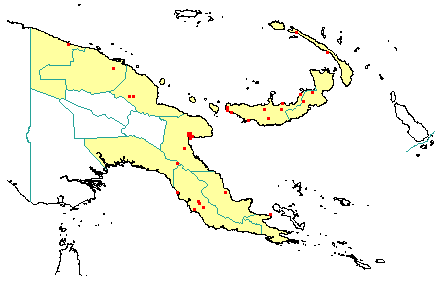
in PNGplants database
PNGTreesKey – Homalium foetidum Benth. |
Barry Conn (NSW) & Kipiro Damas (LAE).
Guide to trees of Papua New Guinea
Copyright held by the authors, National Herbarium of New South Wales, and Papua New Guinea National Herbarium
Journal of the Linnean Society. Botany Vol. 4: 37 (1860)
Other Literature: H. Sleumer, Flora Malesiana, Series 1, (1954)
Family: Salicaceae
Dicotyledon
Timber Group: Major exportable hardwood
Field Characters: Emergent tree (occasionally up to 45 m high), Large canopy tree, or Small sub-canopy tree; Bole cylindrical (up to c. 1 m diam.); straight (bole up to c. 30 m long); buttresses buttresses present (usually buttresses up to c. 2 m high) or buttresses absent; spines spines absent; aerial roots aerial roots absent; stilt roots stilt roots absent; Bark grey (pale to dark) or brown (yellowish (mottled), slightly rough or smooth, scaly or flaky, fissured (transverse), or pustular, lenticels elongated vertically; Subrhytidome (under-bark) yellow, orange, pale red, or pale brown; less than 25 mm thick, 12.0-20.0; bark blaze with two layers; strongly aromatic; unpleasant; outer blaze pale red or pale brown, markings absent, granular without splinters; inner blaze orange, pale red, or pale brown, speckled (orange speckles in section) or with stripes (orange), granular without splinters; bark exudate (sap) present (between bark and sapwood), colourless, not readily flowing (spotty), colour not changing on exposure to air, not sticky; terminal buds not enclosed by leaves.
Indumentum: Complex hairs absent; stinging hairs absent; mature twig indumentum (hairs) present, hairs dense to sparse.
Leaves: Leaves spaced along branches, spiral (leaves occurring singly at a node and arranged spirally up the branchlet), simple (a leaf composed of a single blade); petiole present, not winged, attached to base of leaf blade, not swollen; leaves broadest at or near middle or rarely broadest below middle, (10.0-) 12.0-20.0 (-28.0) cm, 50.0-80.0 (-110.0) cm; very asymmetric to symmetric, nearly entire or crenate (coarsely (rarely shallowly crenate), not dissected or lobed, acuminate (short- to long-acuminate), venation pinnate, secondary veins open, prominent, intramarginal veins absent; leaves lower surface green, upper surface dark green, indumentum (hairs) absent or present, indumentum (hairs) sparse; absent; domatia absent; stipules absent.
Flowers: Inflorescence axillary, flowers on an unbranched axis or flowers on a branched axis, cones absent; flowers bisexual, not stalked (subsessile), flowers with many planes of symmetry, 2.5-3.0 mm long, diameter small (up to10 mm diam.); perianth present, with distinct sepals and petals whorls, inner perianth white (sweetly aromatic) or cream-coloured; 5-(persistent, together with sepals, such that fruit appearing like a shuttle-cock.)-6, free or some or partly joined; stamens 10-20, present, free of each other or at base joined, joined to the perianth; ovary partly inferior, carpels joined (when more than one), locules 4; styles free, 4.
Fruits: Infrutescence arranged on unbranched axis or arranged on branched axis, fruit 4.0 mm long, red or brown, not spiny, non-fleshy (leathery), simple, dehiscent, capsule; seeds 4 (c.), to about 5 mm long, not winged, broad (as wide as long), seed 1-10 mm diam.
Distribution: West Sepik, East Sepik, Madang, Morobe, Gulf, Central, Northern, Milne Bay, New Britain & New Ireland.
 | Botanical records in PNGplants database |
Notes: Notes This genus was previously classified in the family Flacourtiaceae.